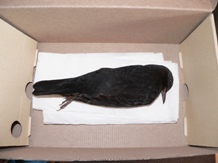 |
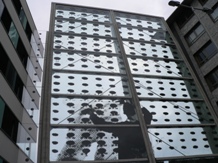 |
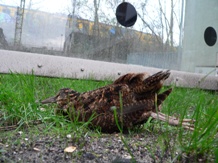 |
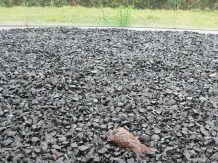 |
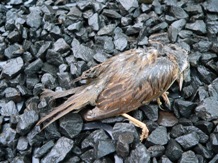 |
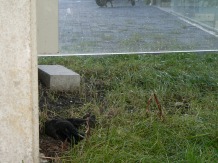 |
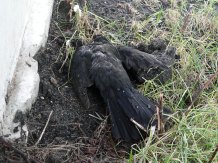 |
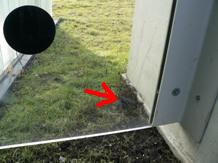 |
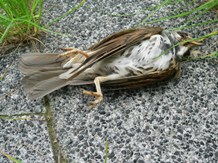 |
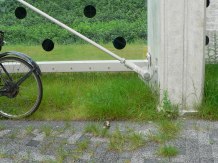 |
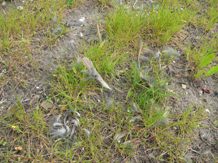 |
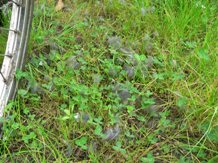 |
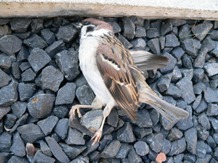 |
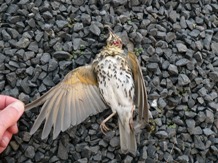 |
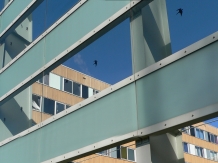 |
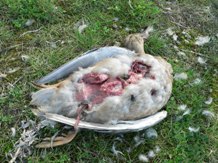 |
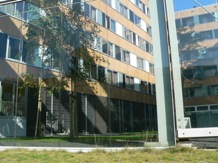 |
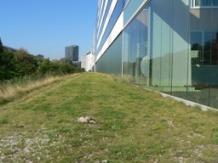 |
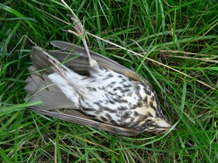 |
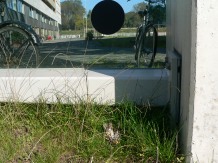 |
On 2 december 2009 on 11.22 AM we received the following message: “Unfortunately I have again sad news from the Carolina MacGillavry Lane. I just came back from ice skating lessons this morning when I saw a bird flying against the screen. Sadly enough I couldn't do anything for the bird. I think it is a Blackbird (…).” On 3 December 2009 I took a picture. The Blackbird, a first year male, hit the screen near the student dormitories. The same day I found a dead Woodcock next to the other screen and in the first courtyard a Dunnock. For the second time now it was observed that a bird flew to its death against parts of the screen with the etched oval dots, part of the artistic image. There is too much room between the oval dots and also between the dots attached on the bottom panels. How many more victims will follow? We hold the city of Amsterdam responsible for this breach of its duty of care. On 3 February 2010, after a period with lots of snow and ice, we did an inspection and yes, found another window-kill, a Blackbird hit the side screen near the entrance of the student dormitories. On 20 February 2010 the case was presented at the Netherlands Society for the Protection of Birds in Zeist, in a meeting of the City Bird Advisors. Click here for the Power Point Presentation (3,72 MB, Dutch). At the same time the pressure on the city of Amsterdam increased. This resulted in a telephone call of the Projectbureau Zuidoostlob on 1 March 2010. It was proposed that we would ask an expert to give an opinion. On our request Jip Louwe Kooijmans, Program Coordinator Urban Environments of the Netherlands Society for the Protection of Birds, visited the location and drafted a report. In this report, dated 17 March 2010 (Dutch), it was concluded that the present measures are not effective. Considering the size of the glass surface, the amount of casualties and the location, Louwe Kooijmans is of the opinion that it is necessary to take permanent and effective measures. His advice is to mark the glass surfaces with vertical lines of 2 cm width and a mutual distance of 10 cm. Visiting the site on 10 October 2010 we found a Tree Sparrow, a Song Trush and a Duck near the student dormitories and another Song Trush next to one of the municipal killing walls. Pictures on the last two rows. On 8 December 2010 we summoned DUWO. On 26 February 2011 we had a meeting with them. They told us they had left the idea to apply 1.224 extra stickers arguing that it would diminish the access of daylight too much. We offered to help them in finding an alternative way. We asked Prof. Klem about WindowAlert, an ultraviolet decal that is sold in the US. However, we doubted this would be a solution. Prof. Klem confirmed this: "I also do not believe the WindowAlert is a solution for you. The UV aspects of WindowAlert are really not helpful in my opinion because the decal transforms the area it covers into a frosted (translucent, non-see-through) area. To be effective they must be applied with great density and replaced perhaps too often." Prof. Klem told us about a Toronto company called The Convenience Group, Inc. that has produced films that have been aesthetically acceptable to those working in the government building where they were applied to stop bird strikes. We contacted this firm and on 8 March 2011 they told us that they are developing a product that could be installed on glass outside of Canada. On 20 April 2011 they emailed that they were over optimistic on coverage outside Canada and hopefully will be in the position to service our requirements before fall migration. On 30 March 2012 we received the message that the firm is focusing on North America at the present time and is not in a position to supply Europe at this time. Since the Canadian firm could not supply the film, we asked for a new meeting with DUWO. Before the meeting took place, in June 2012, the Killing Walls were mentioned in Vogelnieuws, a monthly review of the Netherlands Society for the Protection of Birds. We were pleased with the outcome of the meeting. To reduce the collision risk DUWO was willing to apply vertical stripes on the lower window panes of the inner courts. After this the effects will be measured. We found a company that could do the job. DUWO contacted the company and received a sample. On 31 October 2012 we had a look at the sample. On 29 November 2012 the work started. The stripes are attached in a correct way (vertical, 2 cm-wide with gaps of 10 cm). See picture 1 and picture 2, both made on 30 November 2012. |